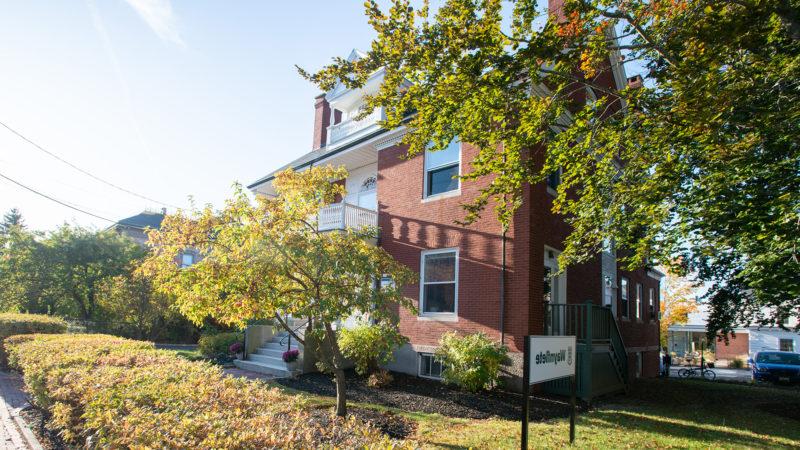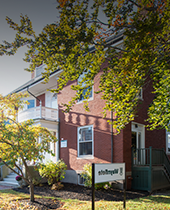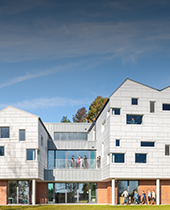As a schoolteacher and pediatrician, Emily Frank ’04 puts lessons learned at Waynflete to good use
Speak with Emily Frank and you will quickly learn this: she likes to wear many hats.
 After four years in the orbit of teachers including Wendy Curtis, Carol Titterton, and David Vaughan, Emily had become passionate about science. During the summer before her freshman year in college, a scholarship at the Maine Medical Center Research Institute provided her with an initial taste of medicine. It was a thrilling experience—“I couldn’t believe that people got paid to do research for a living,” she recalls. After considering a degree in astronomy, Emily chose to major in cell biology after matriculating to Dartmouth College. But as she progressed through the program, she found herself increasingly drawn to the school’s education department. Emily was attracted by the idea of a career that was “somewhere on the science-education spectrum,” and that path began to coalesce into a plan: she would start out as a high school science teacher (to learn effective teaching skills) with the hope of someday becoming a college biology professor.
After four years in the orbit of teachers including Wendy Curtis, Carol Titterton, and David Vaughan, Emily had become passionate about science. During the summer before her freshman year in college, a scholarship at the Maine Medical Center Research Institute provided her with an initial taste of medicine. It was a thrilling experience—“I couldn’t believe that people got paid to do research for a living,” she recalls. After considering a degree in astronomy, Emily chose to major in cell biology after matriculating to Dartmouth College. But as she progressed through the program, she found herself increasingly drawn to the school’s education department. Emily was attracted by the idea of a career that was “somewhere on the science-education spectrum,” and that path began to coalesce into a plan: she would start out as a high school science teacher (to learn effective teaching skills) with the hope of someday becoming a college biology professor.
Emily restructured her junior year at Dartmouth to participate in a mentored teaching program in the Marshall Islands during the winter semester. “It was a life-changing experience,” she recalls, adding that it included “some of the most purposeful and happiest days of my life.” She employed a pedagogical method that will be familiar to most Waynflete faculty members: if a teacher concludes that some aspects of the curriculum are no longer relevant to the students, the teacher can change it. In their science class, students wanted to learn about reproductive issues, diabetes, and the effects of drugs on the brain. “That was what was relevant to them, so that’s what I taught them about,” she says.
Back at college, Emily’s experiences in Dartmouth’s science labs had led her to become disillusioned with academia. She still wanted to teach science, but not at the college level. “I knew my education at Waynflete had been special,” she says. “It was the standard for the quality of education that all kids should receive, regardless of race, income, or life circumstances. What I was coming to better understand, though, was how much a child’s education can depend on their zip code.” After graduating, she resolved to shore up her teaching skills by working with Teach For America (TFA).
During her two-year tenure at TFA, Emily taught middle school life sciences in Vallejo, a community in San Francisco’s North Bay area. Vallejo had been a thriving port city in the 1970s before undergoing economic collapse (around the time that Emily arrived, the municipality had declared bankruptcy due to rising personnel costs and declining revenue from a housing slump). It was a jarring transition for a 23-year-old who had spent most of her life in Brunswick, Portland, and Hanover, but she continued to build confidence in her ability to connect with children. “I just loved getting kids excited about science and seeing the light bulb go on,” she says. School administration didn’t appeal as a career path—she wanted to influence children’s lives in a hands-on way, particularly when she had the opportunity to design curriculum—but she felt she still needed additional tools. Her education journey was to continue in an unorthodox way: she would train to become a medical doctor.
 Emily earned her MD from Tufts University. Tufts’ “Maine Track” program is grounded in a community-based curriculum that enables future physicians to work at clinical sites throughout the state (students spend the majority of their time in Maine). “From the very beginning, I was so impressed with their philosophy of education,” she says. “Although my degree is from Tufts, I really learned how to be a doctor from physicians throughout the state of Maine.”
Emily earned her MD from Tufts University. Tufts’ “Maine Track” program is grounded in a community-based curriculum that enables future physicians to work at clinical sites throughout the state (students spend the majority of their time in Maine). “From the very beginning, I was so impressed with their philosophy of education,” she says. “Although my degree is from Tufts, I really learned how to be a doctor from physicians throughout the state of Maine.”
Partway through her training—a period she recalls as “drowning in biochemistry”—Emily was still driven by the desire to work with students. Along with two TFA alumni, she co-founded Health Impact Partnership in the Jamaica Plain neighborhood in Boston. “When I was in Vallejo, I had really wanted to start a program where kids could identify the health issues that mattered to them and feel supported in taking action to bring about change,” she says. “This was the way to do it.”
There are many programs around the country in which medical school students visit local communities and educate residents on a variety of topics. Emily’s unique idea was to build her new program on a foundation of participatory action research, an approach that, according to the Journal of Epidemiology and Community Health, “aims to improve health and reduce health inequities through involving the people who, in turn, take actions to improve their own health.” Emily and her team worked in a diverse school district that was home to many new immigrants. “We wanted to create something that lifted students up by encouraging them to identify what mattered to them,” she says. “The high school students developed a needs assessment and interpreted the data. Our contribution as medical school students was to support them each step of the way.” The program also provided valuable opportunities for future doctors to strengthen their communication skills in different cultural environments.
Nutrition was top of mind for students in the community. While many were eating healthily at home, few knew how to cook. The students in the program identified high school seniors as a group that was particularly at the risk of suffering from poor nutrition after leaving school. The kids in Emily’s program designed, printed, and distributed a healthy-eating cookbook. “This was a beautiful example of how students’ voices and opinions are so valuable,” she says.
Returning to California
Although Emily was interested in psychiatry and emergency medicine, she decided to specialize in pediatrics. “Pediatricians have a real focus on prevention and advocacy, which resonated with the type of work I wanted to do,” she says. She returned to the Bay Area to complete her residency, which focused on leadership for advancing health equity. As before, Emily helped launch a youth participatory action research project in the Oakland Unified School District, building a series of student lessons that highlighted careers in the healthcare industry. “What was the most fun for me was wearing so many hats,” Emily says. “Designing the curriculum, training adult facilitators, guest teaching, supporting students—I was using all my skill sets, and I loved that feeling.”
Emily became a near-full-time teacher and a part-time physician. Working as a clinical pediatrician in the evenings, on weekends, and during the summer, she began teaching at Life Academy, an Oakland public school serving students in grades 6–12. Founded in 2001, Life Academy seeks to “dramatically interrupt patterns of injustice and inequity for underserved communities in Oakland” by preparing students for challenging careers in health and bioscience. Over the course of their studies, students build an in-depth understanding of public health, health literacy, and health advocacy. It’s a hands-on, experiential program, with kids doing everything from creating educational videos on the Covered California healthcare exchange to establishing bone marrow registration drives in an effort to decrease racial disparities in the registry. Early in the pandemic, COVID-19 infection rates rose rapidly in the neighborhood. In response, students created infographics in a variety of languages to encourage mask use. “To see students feel empowered in the face of national bewilderment, and to provide them with a sense of agency, was really gratifying,” Emily says. “Many of the problems that stem from lack of health literacy or investment are fixable if we enlist our young people to help solve them. Adults don’t have all the answers.”
Diversity in the healthcare industry
It is an unfortunate fact that in many healthcare institutions, racial diversity exists only in lower-level positions. The more education is required, the more homogeneous the workforce becomes. The cycle can be self-reinforcing. When students in predominantly Black and Hispanic communities interact with primarily white doctors, it is difficult for those students to imagine a future career in advanced healthcare. Emily sees this effect come into play as the seniors in her classes begin to consider colleges. “I ask them whether they’ve considered applying to CalTech, MIT,” she says. “They tell me, ‘Oh, I can’t get in.’ I tell them that it’s not for them to decide. That’s for the schools to decide.” Life lessons from Waynflete—finding the courage to knock on what appear to be closed doors and, in the face of rejection, learning to get back up and try again.
There are industry pipeline programs, but most start at the college level—too late, in Emily’s estimation. The high school programs that do exist often target the same small group of students who are clearly performing at a high level. “So many kids just need the flame to be ignited,” she says. “That’s what interests and excites me—to go below the surface and reach out to those students. There are many kids who walk the fine line between tremendous success and awful consequences. They have so much potential— how much of that potential gets used depends on the support they get in middle and high school. I’m really interested in exposing young people who are at risk to opportunities and helping them use their tremendous potential for whatever they want.”
 That exposure includes inviting as many guests of color as possible into the classroom, including doctors, scientists, and other healthcare professionals. “I know that as a white teacher, I can never have the same impact on kids as a teacher of color in their community,” Emily observes. “There are all kinds of cultural nuances that I am oblivious to. Every young person should grow up believing that they are agents of their own future. So I try to ask myself: ‘What I can do, in an ally position, to make sure that my students see the full range of opportunities that can be open to them?’”
That exposure includes inviting as many guests of color as possible into the classroom, including doctors, scientists, and other healthcare professionals. “I know that as a white teacher, I can never have the same impact on kids as a teacher of color in their community,” Emily observes. “There are all kinds of cultural nuances that I am oblivious to. Every young person should grow up believing that they are agents of their own future. So I try to ask myself: ‘What I can do, in an ally position, to make sure that my students see the full range of opportunities that can be open to them?’”
Dreaming it
Emily’s belief in the importance of listening to kids and lifting up their voices is rooted in her memories of Waynflete. “Two of the most important things I learned are that your voice matters and that you can do anything,” she says. “If you can dream it, and if you can identify resources you can draw on, you can ultimately do it.” Waynflete teachers are often the standard by which she judges her success in the classroom today. They also inspire specific pedagogical approaches. Debba Curtis, one of Emily’s favorite teachers, had students complete “SARs” (summary, analysis, reaction) for every primary document and article read in class. “I now teach my ninth graders how to SAR,” she says. “How do you take a piece of literature or something in the news and determine what it’s about, why it matters, and how you feel about it?”
Effective time management is essential for someone balancing two demanding professions. “It starts with
being clear about what you value—what matters most to you—and what you’re willing to compromise on or let go of,” she says. “While there are some things I have to give up, doing so lets me do the work I value most.” Emily loves to hike, cook, dance, and do yoga. Even when her schedule becomes extreme, exercise is non negotiable. “I couldn’t manage without it,” she says.
Like those of most doctors and teachers, Emily’s working life over the past year has been dominated by the pandemic. Looking longer term, she plans to continue working on what has emerged as a specialty for her: creating high-impact experiences that have positive effects on both students and the healthcare industry. She hopes to expand her work at Life Academy to the entire Oakland school district (the pandemic has demonstrated that it is possible to conduct the program virtually) and get greater buy-in from hospitals and other organizations that are eager to diversify their workforces and build pools of future talent.
When asked what counsel she would give to today’s high school students, Emily reflects on advice that she received from a friend years ago: explore as much as you can, and in the process of doing so, observe what brings out “the best you.” “While pediatrics allows me to wear my preventative and advocacy hats, it also gives me the opportunity to make silly faces, or sing a song, or be ridiculous with a child,” she says. “I love that pediatrics brings this out in me. It’s the same with teaching. The people who know me best have spent time in my classroom. This is where ‘me’ comes out to the maximum.”



